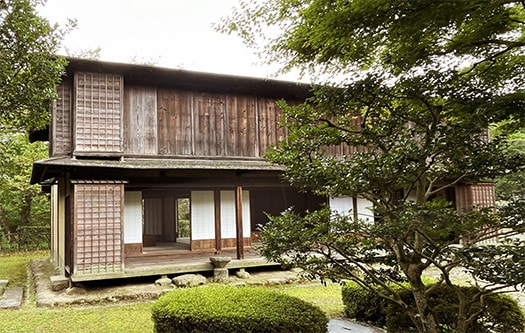


昨日までは会議参加などで東京に出張しておりました。昨年、環境の変化があったのですが、それ以来推移を注意深く見守るような時間が経過している次第。ちょうど1年間の期間が過ぎてきて、ひとつの節目になっておりました。今後は徐々に自分自身のテーマ領域に向かって集中していきたいと考えています。またそういう領域の「取材」もしてきていました。
東京は不思議な「季節感への無感覚」時間。どうもほとんど暑さは感じずに、長袖でも短袖でもどっちでもいいような空気感。一方帰ってきた札幌は秋を感じる気配。今日からは新環境での本格的始動とも考えています。今後ともよろしく。
住宅写真主体のブログは最近継続中の「福島市民家園」シリーズです。本日の建物は「元・客自軒」という福島市で有数の割烹旅館。この建物は幕末期の歴史上重要な舞台になったことで知られている。新政府軍と奥羽同盟軍との戦いは会津の攻城戦がもっとも激戦地になった。敗者になった会津は下北半島に国替えされることになって、深い恨みを新政府に対して抱くようになる。一方でこの福島市でも、新政府の「奥羽征討軍」の下参謀・世良修蔵が佐幕派の仙台藩士に襲撃され、この「客自軒」に引き立てられた後、阿武隈川河畔で惨殺されたという事件が発生した。この下参謀(しもさんぼう)というのは、明治維新・戊辰戦争の際に東北地方を従えるための奥羽鎮撫総督府に置かれた役職。総督の下に副総督・参謀と共に置かれ、このうち総督・副総督・参謀には公家が任命され、下参謀には武家の代表者が任命された。公家の総督・副総督・参謀はいわば“お飾り”に過ぎず、総督府の実権は武家である2人の下参謀(薩摩藩・長州藩出身)が握った。 この世良修蔵は長州の第二奇兵隊の軍監だった。
この客自軒建築は、その後1878年には福島町議員選挙の「投票所」にも使われた。
復元には江戸後期とされる創建時に近い形に復元された。解体前には4棟があったけれど、創建時の2棟のみを復元したのだという。建築部材はほっそりとした柱梁が使われていて、当時の「町屋造り」の手法に近い、略式の「数寄屋造り」手法とされている。
English version⬇
Kappo Ryokan Kyakujiken” in Fukushima at the end of the Edo Period / Fukushima City Minkaen-7
Kappo Ryokan was the scene of a deadly attack during the final days of the Meiji Restoration. A substantial government military staff member was attacked here. Light sukiya-style architecture. ...
Until yesterday, I was in Tokyo on a business trip to attend a conference. Last year, there was a change in the environment, and since then, I have been watching the transition carefully. I have just passed the one-year period, which was a milestone for me. From now on, I would like to gradually concentrate on my own theme area. I have also been “covering” such areas.
Tokyo is a strange “numb to the seasons” time. I hardly felt the heat, and the air felt as if it didn't matter whether I wore long or short sleeves. On the other hand, Sapporo, where I came back from, feels like autumn. Today is the first day of work in the new environment. I look forward to working with you in the future.
This is the ongoing “Fukushima City Minka-en” series, a blog mainly featuring photos of houses. Today's building is “Kyakujiken,” one of the most famous kappo ryokan (Japanese-style restaurant) in Fukushima City. This building is known to have been an important stage in the history of the end of the Edo period. The battle between the new government forces and the Ou Alliance forces was the most fierce in the siege of Aizu. Aizu, which was the loser, was transferred to the Shimokita Peninsula, and came to harbor deep resentment toward the new government. Meanwhile, in Fukushima City, Shuzo Sera, a subordinate general staff member of the new government's “Ou Conquest Army,” was attacked by Sendai clan fighters of the Sabaku faction and brought to Kyakujiken, where he was brutally murdered on the banks of the Abukuma River. The position of “Shimo-sambo” was assigned to the Ou Governor-General's Office to control the Tohoku region during the Meiji Restoration and the Boshin War. The governor-general, deputy governor-general, and general staff were appointed by court nobles, while representatives of the samurai class were appointed to the position of subordinate counselors. The governor-general, vice governor-general, and general staff were merely “decorations,” so to speak, and the real power of the governor-general's office was held by the two subordinate general staff members (from the Satsuma and Choshu clans), who were samurai. Shuzo Sera was the military commander of the Choshu's 2nd Kibeitai.
This Kyakujiken building was later used as a “polling station” for the Fukushima Town Council election in 1878.
The building was restored to a form close to that of its original construction, which is believed to have been in the late Edo period. There were four buildings before the demolition, but only two were restored to their original state. The building is constructed with slender pillars and beams, and is said to have been built in the abbreviated “sukiya-zukuri” style, similar to the “machiya-zukuri” style of the time.




























※コメント投稿者のブログIDはブログ作成者のみに通知されます